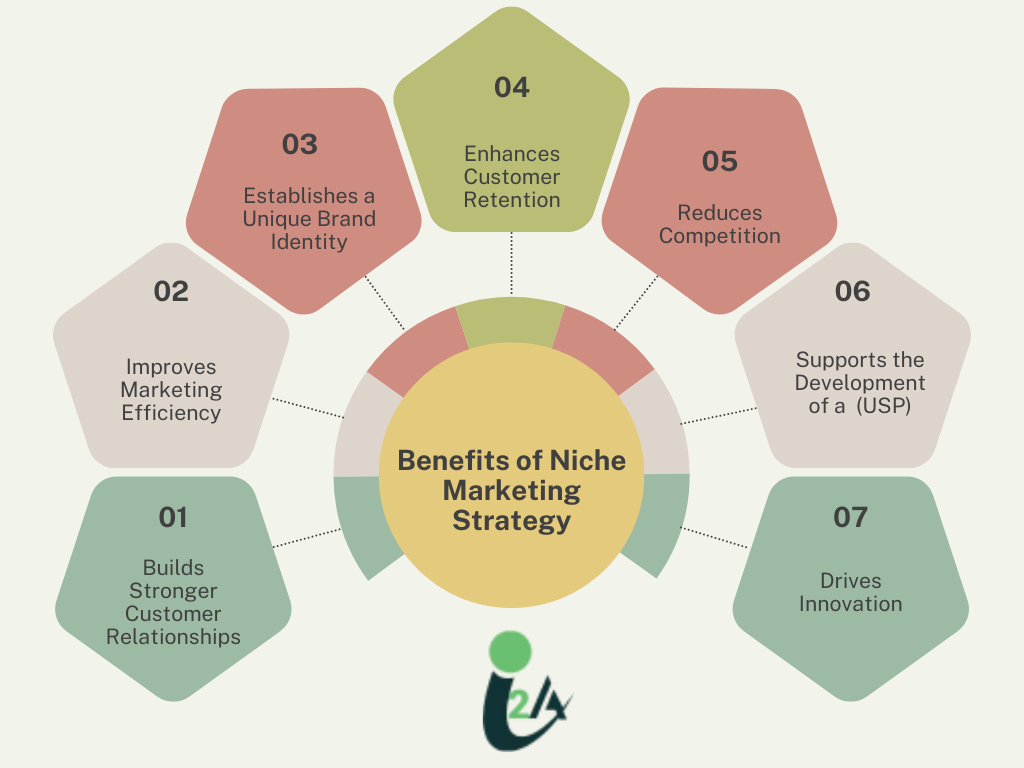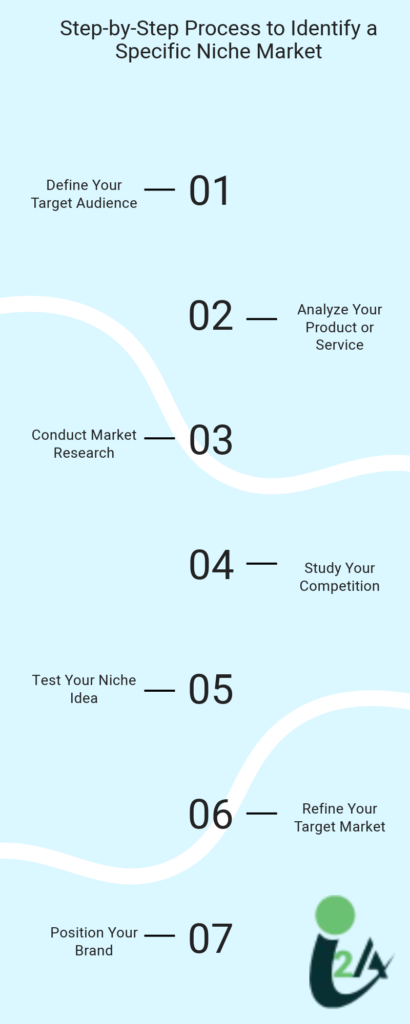What is a Niche Marketing Strategy?
A niche marketing strategy focuses on targeting a specialized market with specific needs, preferences, or identity. Instead of catering to a broad audience, businesses zero in on a smaller, well-defined segment to deliver tailored products or services that address the unique challenges of their target market.
For example, brands like Peloton cater to high-end fitness enthusiasts seeking interactive workout solutions, while Warby Parker revolutionized eyewear for price-conscious consumers by offering affordable, stylish frames online. Etsy, a platform for artisans and small manufacturers, exemplifies how niche marketing helps businesses tap into unique customer needs effectively.
Niche strategies are particularly beneficial for small businesses and startups, where competing against established players in a saturated market may seem daunting. This approach lowers the barrier to entry, helps businesses stand out, and is ideal for entering new markets or building customer loyalty. Over time, niche strategies foster a recognizable brand and develop a loyal customer base by meeting the specific needs of potential customers.
The foundation of a successful niche strategy lies in audience segmentation—breaking down a larger market into smaller, more focused groups with distinct needs. It involves identifying the target market, understanding their preferences, and building a unique value proposition. By focusing on a specialized market, businesses can craft tailored offerings that resonate deeply with their audience and ensure sustained growth.
Benefits of Niche Marketing Strategy

- Builds Stronger Customer Relationships
Niche marketing helps businesses develop deeper connections with their target audience by catering to their specific needs. By focusing on a specialized market, companies can deliver tailored solutions that foster trust and loyalty.
For example, Amit Chauhan led comapny, I2A Technologies offers tech-based solutions to travel clients, providing easy booking, cancellations, and personalized tour packages, which strengthens relationships with tech-savvy travelers seeking affordability.
- Improves Marketing Efficiency
Focusing on a targeted audience reduces wasted efforts and ensures that marketing campaigns reach the right people. Targeted campaigns allow businesses to allocate resources more effectively, resulting in higher ROI. With clear market segmentation, businesses can craft messages that resonate with their audience, boosting engagement and conversions.
“Marketing efforts must be well supported by technology in place. In I2A Technologies, whenever we are building a product or service and is going commercial, we have our own in-house CRM to track the customer journery. Automation and digitization speeds up your processes and gives you efficiency”
Amit Chauhan-Founder and CEO, I2A Technologies Private Limited
- Establishes a Unique Brand Identity
A niche marketing strategy allows businesses to position themselves as experts within a specific field. This creates a unique brand that stands out in a crowded marketplace. For instance, a company specializing in eco-friendly packaging for restaurants can establish itself as the go-to brand for sustainability-focused businesses.
- Enhances Customer Retention
By addressing the needs of a highly specific audience, businesses create solutions that are harder for competitors to replicate. This fosters long-term loyalty and repeat business. Niche marketing strategies not only attract new customers but also ensure existing ones remain engaged through consistent value delivery.
- Reduces Competition
Operating in a specialized market minimizes direct competition with larger, generalized brands. Businesses can carve out their unique space by understanding their target audience’s pain points through market research. This enables companies to focus on delivering value without battling for attention in a saturated marketplace.
- Supports the Development of a Unique Selling Proposition (USP)
A clear USP sets a business apart by highlighting what makes its products or services distinct. Niche strategies encourage businesses to align their USP with their audience’s specific needs. For example, a tech firm offering data security solutions tailored to small businesses emphasizes affordability and simplicity, attracting clients who prioritize ease of use.
- Drives Innovation
Specialized markets often demand creative solutions, encouraging businesses to innovate. By understanding the unique challenges of their audience, companies can develop offerings that better serve their customers while staying ahead of competitors.
How to Identify a Specific Niche Market?
Need to Identify a Niche Market?
Identifying a specific niche market ensures that your niche marketing efforts are targeted and effective. By understanding your audience and refining your strategy through continuous research and feedback, you can build a sustainable business that caters to the unique needs of a niche audience, standing out from the mass market and gaining loyal customers in the process.
Key Elements Involved in Identifying a Niche Market
- Market Research: Understand the broader market landscape, analyze trends, and identify gaps where a specific niche audience is underserved.
- Competitor Analysis: Study competitors in your industry to find opportunities where you can differentiate your offerings. Identifying spaces with fewer competitors can give you a strong advantage.
- Product Positioning: Clearly define how your product or service solves a unique problem for your ideal customers. Position your business as a unique brand within a crowded market.
- Idea Testing: Gather feedback from potential customers to validate your niche. Testing helps refine your understanding of their preferences and ensures alignment with your niche marketing efforts.
Step-by-Step Process to Identify a Specific Niche Market

Step 1: Define Your Target Audience:
Start by identifying the demographics, behaviors, and preferences of your target audience. Consider factors like age, income, interests, and pain points to create a detailed customer profile.
Step 2: Analyze Your Product or Service:
Evaluate what makes your offering unique. Ask yourself: What problem does it solve? How does it stand out in a mass market? This clarity will help you align with a specific niche.
Step 3: Conduct Market Research
Use surveys, industry reports, and customer feedback to uncover trends. Research helps you identify areas where customers’ needs are unmet, creating opportunities to cater to a smaller target market.
Step 4: Study Your Competition
Identify competitors within your niche and evaluate their strengths and weaknesses. Look for gaps in their offerings that your business can fill, enabling you to stand out in a crowded market.
Step 5: Test Your Niche Idea
Validate your concept by testing it with a sample of your niche audience. Use feedback to refine your product or service and ensure it aligns with the preferences of your ideal customers.
Step 6: Refine Your Target Market
Narrow down your audience to focus on those who are most likely to become loyal customers. This step ensures your marketing efforts are directed at the right group, maximizing your ROI.
Step 7: Position Your Brand
Establish your business as a unique brand that resonates deeply with your niche. Develop messaging that highlights how your offerings meet the needs of your target audience better than competitors.
Blue Ocean and Red Ocean Strategy
The Blue Ocean Strategy and Red Ocean Strategy are two distinct approaches to market competition, and understanding their differences can elevate your niche marketing strategies to a professional level. These strategies help businesses identify whether to compete in crowded markets (Red Ocean) or carve out untapped opportunities (Blue Ocean).
Understanding Red Ocean Strategy
The Red Ocean Strategy refers to competing within established markets, where businesses focus on outperforming rivals in a saturated market segment. Here, niche marketing focuses on refining products or services to better meet customer needs while competing on price or differentiation.
While this approach can yield results, it often leads to intense competition and reduced margins. A niche business operating in a Red Ocean must implement niche marketing campaigns that highlight its unique features to stand out among competitors.
Exploring Blue Ocean Strategy
The Blue Ocean Strategy, on the other hand, emphasizes creating new, untapped markets where competition is irrelevant. This strategy aligns perfectly with niche marketing as it encourages businesses to identify unmet needs and deliver innovative solutions that redefine market dynamics.
For example, Warby Parker leveraged a Blue Ocean Strategy in the eyewear industry by offering affordable, stylish glasses through a direct-to-consumer model. This approach not only created a new market segment but also eliminated the need to compete with traditional retailers.
Amit Chauhan shares an expert tip on how to apply a Blue Ocean Strategy “To adopt a Blue Ocean Strategy, focus on identifying pain points that are often overlooked by competitors in your market. Combine innovative ideas with niche marketing strategies to create solutions that resonate with underserved customers. This approach can transform a business into a category leader within niche markets.”
Which Strategy Suits Your Niche Business?
Businesses focusing on niche markets should assess whether their audience lies within a crowded Red Ocean or an untapped Blue Ocean. While Red Ocean strategies rely on differentiation and efficiency, Blue Ocean strategies demand a fresh perspective and a willingness to take risks in creating new opportunities.
For niche marketing, a blend of these strategies can also work. For instance, a niche business might begin in a Red Ocean by targeting a well-established audience and then gradually pivot to a Blue Ocean by innovating its offerings.
By understanding and applying the principles of Blue and Red Ocean strategies, businesses can refine their niche marketing campaigns and align their efforts with market realities. Whether competing in saturated markets or creating entirely new ones, these strategies ensure that businesses stay agile and ahead of their competition.
Marketing for Niche Markets
Building a Unique Selling Proposition (USP)
A unique selling proposition (USP) is the foundation of a successful niche marketing strategy. It highlights what makes your product or service distinct and valuable to your target market. In niche marketing, the USP should resonate deeply with a specific group, addressing their particular needs and offering a solution competitors cannot easily replicate. For instance, a gender-inclusive clothing brand might emphasize ethical production and fair working conditions as its USP to attract ethically minded consumers.
To craft an effective USP, focus on understanding your niche audience through market research and customer feedback. This will ensure your USP aligns with their values, preferences, and pain points, establishing a well-defined brand within a crowded market.
Strategies for Niche Marketing
Product Differentiation
Offer unique features or benefits that cater to your niche market. For example, a pet brand targeting pet owners might offer customized, organic pet food to meet the particular needs of health-conscious customers.
Price and Functionality
Position your niche offering competitively in terms of price or functionality. Niche businesses like Dollar Shave Club excel by combining affordability with convenience, appealing to a specific target audience.
Hyperpersonalization:
Tailor your offerings to address highly specific demands. For example, creating sustainable development goals-aligned products for socially conscious consumers can set you apart in a specialized market.
Focus on Relationship Marketing:
Build a loyal customer base by prioritizing customer relationships and offering personalized service. Use incentives like discount codes or free dog treats to enhance loyalty and retention.
Digital Strategies for Niche Markets
Targeted Advertising:
Utilize social media platforms to run social media ads aimed at your targeted audience. Platforms like Facebook and Instagram allow businesses focusing on niche audiences to deliver highly targeted campaigns.
Content Marketing:
Create content tailored for your niche audience, addressing their needs, challenges, and values. Blog posts, videos, and infographics that align with your niche marketing strategy can establish authority and boost engagement.
Performance Marketing:
Track and optimize campaigns using data-driven approaches. Performance marketing ensures your marketing efforts yield measurable results, especially when targeting a smaller target market.
Social Media Engagement:
Leverage platforms to connect directly with your potential customers. Interact with followers, answer queries, and promote your niche brand through meaningful dialogue. For instance, a niche business targeting ethical production can share stories of their supply chain transparency to build trust with ethically minded consumers.
Email Campaigns:
Develop personalized email campaigns for your niche audience. Tailored communication can help convert leads into loyal customers while promoting niche offerings like exclusive products or celebrity clientele endorsements.
Amit Chauhan’s Views on Niche Strategy
Niche marketing empowers businesses to connect deeply with specific audiences, build loyalty, and achieve sustainable growth. By leveraging tailored strategies, a unique value proposition, and targeted campaigns, companies can thrive in specialized markets while standing out from broader competition.


 Steve Smith
Steve Smith 


